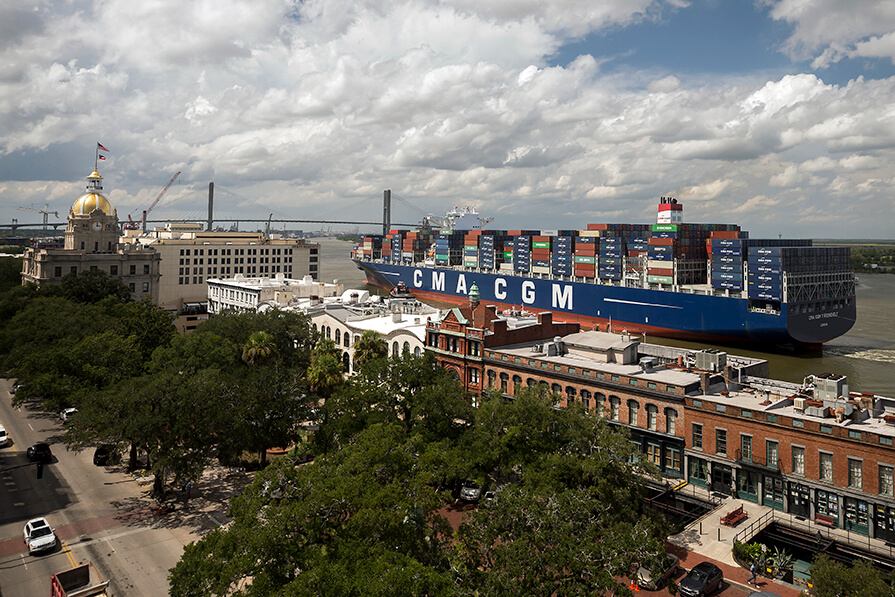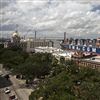
Dear friends and colleagues,
On behalf of the Georgia Ports Authority, I wanted to take a moment to send you our best wishes for a happy holiday and prosperous New Year, share our most recent results, and give you GPA's outlook for 2018.
November was particularly rewarding because of the strength of our performance across the board.
The GPA handled 2.8 million tons of cargo in November, an increase of 215,600 tons or 8.4 percent compared to the same month a year ago.
While container tons increased 5.3 percent to make up 2.37 million tons of the total, GPA terminals also marked large increases in both breakbulk and bulk cargoes.
Overall, breakbulk tonnage increased by 25 percent (50,000 tons) to reach 248,500 tons in November.
At the Port of Savannah's Ocean Terminal, breakbulk expansion was led by lumber, as well as iron and steel. Both categories increased by 50 percent over November 2016 in support of growing demand in construction and manufacturing.
Total bulk cargo crossing GPA's docks in November reached 170,700 tons, for growth of 37 percent or 46,000 tons. At East River Terminal in Brunswick, terminal operator Logistec handled more than triple the business in bulk cargo compared to the same month a year ago. Most of that growth came in increased November demand for wood pellets, perlite and dry urea.
In terms of twenty-foot equivalent container units, the Port of Savannah's trade increased by 2.8 percent (8,500 TEUs) to reach 309,000 TEUs for the month. November marked 13 straight months of growth in container trade, with every month in 2017 above 300,000 TEUs at Garden City Terminal.
Also in November, Drewry Maritime Advisers released its port connectivity index, ranking Savannah as North America's most connected container port. The index is based on the number of direct shipping services, and the number of world regions those services directly connect to. Drewry's research showed Savannah's 36 weekly vessel calls provide superior service to Europe, Asia and other global destinations.
The independent consulting firm stated port connectivity is a significant competitive advantage. We couldn't agree more.
In order to ensure the Port of Savannah remains the fastest growing port in America, the GPA is moving forward with an ambitious terminal investment program.

On the day before Thanksgiving, Savannah received four additional Neo-Panamax cranes. This latest crane delivery brings Garden City Terminal's fleet to 30, with six additional cranes arriving in 2020.
When all are commissioned, the upgrade will allow the nation's largest single container facility to move nearly 1,300 containers per hour across a single dock.
In 2018, we will open the Appalachian Regional Port, an inland rail facility in Northwest Georgia, extending our terminal gates by 388 miles. The inland port offers an efficient option to an all-truck dray to the Port of Savannah for target markets in Georgia, Alabama, Tennessee and Kentucky. The availability of import, export and domestic transit will benefit shippers and beneficial cargo owners throughout the region. As our network continues to grow, we expect to announce in 2018 the site of our next two inland terminals.
For motor carriers, the Authority is expanding truck gates at Garden City Terminal.
The $13.2 million project will increase the terminal's gate infrastructure by 17 percent for a total of 56 truck lanes. The addition will help the GPA seamlessly absorb future growth and offer a better link to the Jimmy Deloach Parkway, which provides a direct truck route to Interstate 95.
In private investment, developers have added 4 million square feet of industrial space over the past year in the Savannah market, for a total of more than 53 million. Another 4 million square feet are under construction to serve the warehousing, transload and manufacturing sectors.

At our Colonel's Island autoport in Brunswick, we have increased roll-on/roll-off capacity by 50 percent, from 60,000 spaces for vehicle processing to the current 90,000. Full build-out will provide 150,000 spaces, growing annual capacity from 800,000 vehicles to 1.4 million cars and trucks. In the coming year, we expect to enhance the terminal's productivity through improved connections between the north and south ends of Colonel's Island.
The Georgia Ports Authority's central purpose is to strengthen industries by providing the most efficient connections to global commerce. World-class terminal infrastructure and commitment to investing in the future assures growing enterprises that Georgia is the best place to locate or expand a business. Coupled with private investment, Georgia is blessed with an unmatched capacity to accommodate additional business.
I want to thank you for your trust in the Georgia Ports Authority over the past year, and invite you to let us help you find even greater success in 2018.
Happy Holidays,

Griff Lynch



